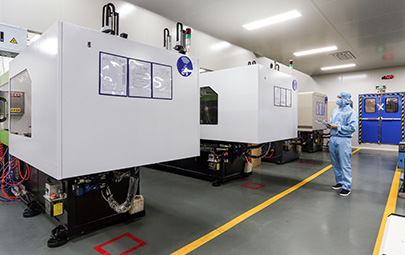Share PET plastic injection molding technology
- Date:2022-12-13
- Read:2960
PET plastic injection molding process is one of the most important technologies in plastic processing. For PET plastic bottles, plastic packaging plants will use blow molding in most cases, but the injection molding process has special processing advantages. For PET plastic injection molding, technicians need to consider many factors, as follows.
Introduction to PET plastics:
The chemical name of PET is polyethylene terephthalate, also known as polyester. At present, GF-PET is the most widely used among customers, and the most important thing is bottle making.
The rheology of PET in the molten state is better, and the influence of pressure on viscosity is greater than that of temperature. Therefore, it is important to start from the pressure to change the fluidity of the melt.
Chemical and physical properties of PET:
The glass transition temperature of PET is about 165 ℃, and the crystallization temperature range of PET is 120~220 ℃. PET has very strong hygroscopicity under high temperature. For glass fiber reinforced PET materials, bending deformation is also very easy to occur at high temperatures.
The crystallinity of the material can be improved by adding crystal strengthening agent. Transparent products processed with PET have glossiness and thermal distortion temperature. Special additives such as mica can be added to PET to minimize bending deformation. If lower mold temperature is used, transparent products can also be obtained by using unfilled PET materials.
Injection molding process:
Injection molding is important for the molding of reinforced PET. Screw injection machines are generally used. Generally, the screw should be hardened to prevent wear after years of use. The length of the nozzle hole of the injection machine should be as short as possible, and its diameter should be controlled at about 3mm.
The melting point of reinforced PET is up to 260 ℃. To prevent nozzle blockage, a heater with high power should be installed. In addition, the tip of the nozzle hole is best processed into the reverse cone type as shown in Fig. 1, so that the molten materials in the flow passage and nozzle can be easily cut off.
Injection molding machine:
Injection molding is important for the molding of reinforced PET. Generally, PET can only be molded by screw injection molding machine.
It is best to select the mutant screw with check ring at the top. Its surface hardness is high, so it is wear-resistant. Its length and diameter are higher than that of L/D = (15 ~ 20): 1, and the compression ratio is about 3:1.
L/D very large materials stay in the barrel for a long time, which is easy to degrade and affect the performance of the product due to excessive heating. The compression is higher than the very small shear, which generates less heat, is prone to poor plasticization, and the product performance is poor. Conversely, it will cause more fracture of glass fiber and decrease the mechanical properties. When processing glass fiber reinforced PET, the inner wall of the barrel is severely worn, and the barrel is made of wear-resistant materials or lined with wear-resistant materials.
The nozzle should be short, the inner wall should be polished, and the aperture should be as large as possible. The hydraulic brake valve type nozzle is preferred. The nozzle shall be provided with thermal insulation and temperature control measures to ensure that the nozzle will not freeze and block. However, the nozzle temperature should not be too high, which may cause salivation. Low pressure PP material must be used to clean the barrel after forming.
Main injection molding conditions of PET:
1. Barrel temperature. The forming temperature range of PET is narrow, and the temperature will directly affect the performance of products. If the temperature is too low, the plasticization is not good, causing the plastic parts to have defects such as depression and material shortage; On the contrary, such high temperature will cause overflow, nozzle salivation, deeper taste, lower mechanical strength and degradation. Generally, the barrel temperature is controlled at 240~280 ℃, and the barrel temperature of glass fiber reinforced PET is 250~290 ℃, which shall not exceed 300 ℃. The nozzle temperature is generally 10~20 ℃ lower than the barrel temperature
2. Mold temperature. The mold temperature directly affects the cooling rate and crystallinity of the melt, and the properties of the plastic parts vary with the crystallinity. Generally, the mold temperature is controlled at 100~140 ℃. If thin-walled plastic parts are formed, a small value can be taken; When forming thick wall plastic parts, large value can be taken.
3. Injection pressure. PET melt has good fluidity and is easy to be molded. Generally, medium pressure is used, with the pressure of 80~140MPa and the injection pressure of glass fiber reinforced PET as 90~150MPa. The determination of injection pressure shall consider the viscosity of PET, the type and quantity of filler, the location and size of gate, the shape and size of plastic parts, mold temperature, type of injection molding machine, etc.
PREVShare PET plastic related knowledge
